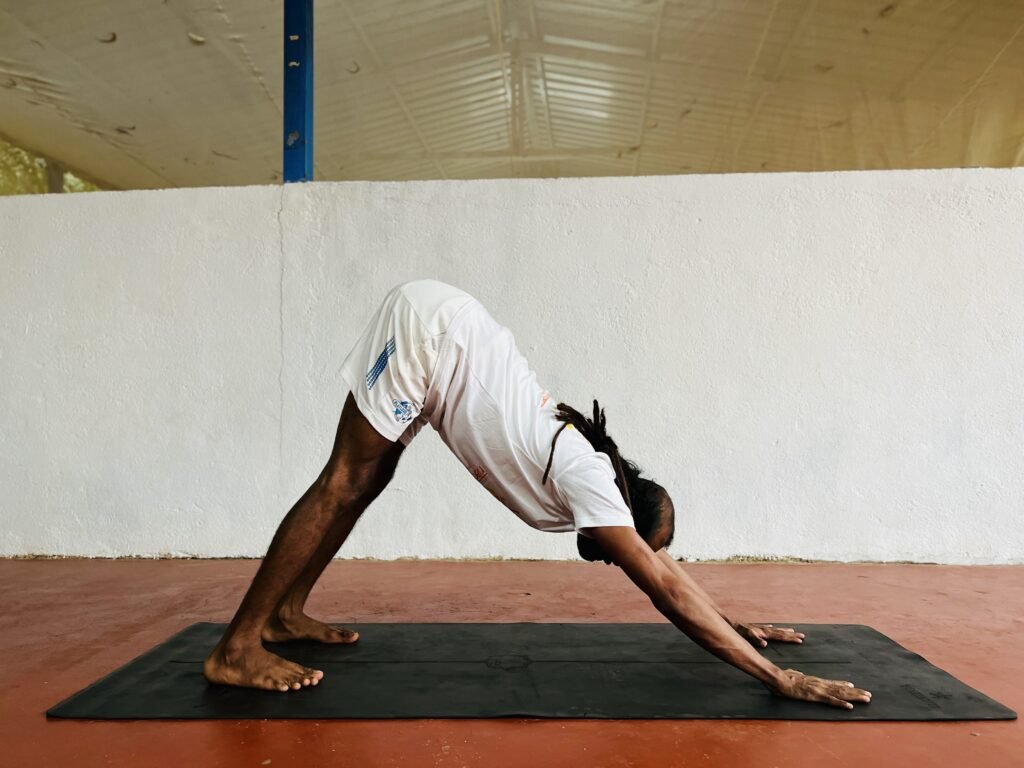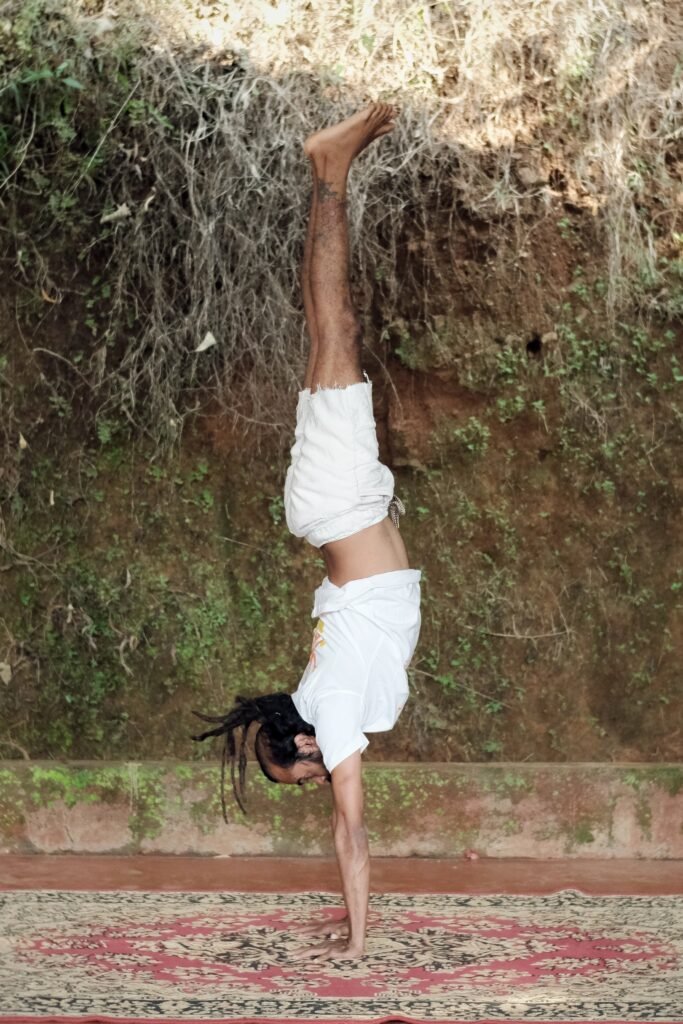
The Adho Mukha Vrksasana, more commonly referred to as the handstand position, is an excellent asana for developing upper-body strength and balance. Shoulders, arms, and wrists are all targeted by this exercise. It is essentially doing tāḍāsana upside down, keeping the body erect and fully engaged.
The practice of Handstand Pose demands a solid foundation of the arms and shoulders, the capacity to pull the hips up, awareness of the breath, and core muscle power; however, getting out of the fear of falling is the most crucial component of this practice. Because it is a balancing posture, it requires the utmost focus and concentration on the gaze, also known as drishti, and the breath.
STEPS FOR ADHO MUKHA VRKSASANA:
Step 1:
Start in Adho Mukha Svanasana. Position your hands so they are shoulder-width apart, and spread your fingers wide to have a strong hold on the mat to improve your balance. Your middle fingers are parallel, and the inside of your elbows face each other.
Step 2:
Bring your feet a little bit nearer to your hands.
Step 3:
Raise one of your legs; in most cases, the leg you choose to raise will be selected for you automatically. Maintain a square hip relationship to the ground while keeping the legs active and extended.
Step 4:
Raise yourself onto the tips of your toes with the foot still planted on the ground. Knees should be bent, and a little kick should be made before going up onto the hands and embracing the knee towards the belly. Toes should be pointed upward.
This action effectively stimulates the core and gains control of the pose so you do not lose your balance.
In addition, it helps prevent your hips from collapsing into a banana shape, which is another benefit of this exercise.
Step 5:
Begin to extend the knee of the bent leg until it is parallel to the ground.
Step 6:
Press your thumbs down into the palms of your hands.
To maintain your equilibrium, you must keep your core and glutes active.
Your thighs should be twisted inward, and your toes should be pointed upward as if you were reaching for the sky.
Hold the position for as long as possible while taking as many deep breaths as possible.
Step 7:
Start by lowering one leg down, then slowly lower the other leg down after it. The child’s pose is a resting position, so come into it and take a few deep breaths.

BENEFITS OF DOWNWARD FACING TREE POSE:
Strength and Flexibility:
The practice of Handstand Pose requires a combined effort from multiple muscle groups and joints, including those of the core (including the transverse and rectus abdominis, internal and external obliques), upper body (including the trapezius, triceps, and deltoids), pelvic floor (including the psoas and adductors), and wrists, shoulders, and hip flexors.
Cardiovascular System and Adrenal Glands:
Jumping up onto your hands to perform Adho Mukha Vrksasana (Handstand Pose), is a movement that, when repeated frequently, helps the body store more energy. This energy causes a rush of adrenaline, which in turn serves to enhance the flow of blood to the brain and the muscles. Therefore increasing the rate of heartbeat and maintaining an elevated level of cardiovascular exercise.
Focus and Balance:
The practice of Handstand Pose demands balance abilities, which come with attention and concentration, to keep the shoulders aligned with the wrists. This pose also requires focus and concentration to practice. The most challenging aspect of this exercise is keeping one’s body upright without falling backward, which can be tricky at first.Even though being in an inverted position causes the brain to become disoriented, it is possible to overcome this obstacle by concentrating harder and improving one’s balance.
Breath and Awareness:
When the body is inverted, the weight of the organs in the abdomen press into the diaphragm, causing it to expand. This is important for energy and breath awareness. Because of this, the lungs can take in deeper breaths, resulting in a greater amount of carbon dioxide being evacuated from the body with each breath.This improves one’s awareness of their breath, boosting their total vitality and prana in the body.
Spine and Bones:
Adho Mukha Vrksasana, also known as Handstand Pose, helps extend and lengthen the spine when it is performed over time and with improved balance.Inverting the body helps to extend the spine, which can help reverse the degeneration of the spine that can occur as a result of compression.The anti-gravity action on the legs and lower body helps discharge built-up lactic acid, which is beneficial for recovery after strenuous exercise.
Stress and Calmness:
You might wonder how someone practicing an asana that is so strenuous could find it relaxing. The explanation can be found in the blood circulation is done backward.This inverted position supplies the brain with an increased supply of blood and oxygen, which, in turn, causes the brain to transmit signals to the neurological system of the body.The activation of the parasympathetic nervous system, which helps reduce levels of the stress hormone cortisol, is one of the effects.This aids in the fight against anxiety and/or sadness of a milder nature.You can get yourself in a better mood by doing handstands.
Others:
Last but not least, like another inversion, this pose also assists with enhanced blood circulation in the head and face, improving skin and hair texture. Inversions, on the other hand, specifically stimulate the seventh and eighth chakras. Sthiram, when attained via the practice of Adho Mukha Vrksasana (Handstand Pose), serves to offer a new perspective to life by activating the Crown Chakra (Sahasrara Chakra). This results in a humbling effect, which makes it a grounding exercise.
Contraindications for the Downward-Facing Tree Pose are as follows:
Women:
Pregnant women are not allowed to practice this asana because of how challenging it is for their bodies at this stage of their development. It may become more difficult to breathe due to the additional weight of the abdomen and the uterus. Because it will restrict blood flow, menstruating ladies should refrain from performing this asana for the duration of their period.
Heart and Blood Pressure:
Jumping into Handstand Pose is a cardiovascular activity. Because of this, individuals who suffer from high blood pressure or heart troubles should not practice it. Students with a history of low blood pressure should also take it easy and practice yoga under the supervision of an instructor because a quick rush of blood to the head can make them feel lightheaded.
Anxiety and Depression:
Handstands may help some people deal with concerns associated with anxiety and depression; nevertheless, individuals whose illnesses are severe should use caution when performing handstands. Avoiding situations that could worsen their symptoms, such as those involving a sudden flow of blood, a lack of confidence, being inverted, not being conscious of their breath, etc., is recommended.
Injury and Surgery:
Students who have sustained wrist or shoulder injuries due to an accident or surgery should refrain from returning to school until they fully recover.
Before attempting this more difficult version, they should try the beginner’s variations to determine whether or not their upper bodies are strong enough to support the weight.
The pressure exerted on the body in an inverted position makes it unsafe for anyone who has sustained an injury to any other portion of their body. Students who have undergone any procedure involving the abdominal organs are not permitted to undertake this asana until they have received clearance from their attending physician.
Back difficulties:
Students with back issues such as a sliding disc or a disc bulge should not undertake the practice of Adho Mukha Vrksasana (Handstand Pose) because of the pressure placed on the vertebrae. At the same time, the body is in an upside-down position.
